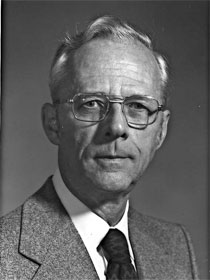
University of Nebraska–Lincoln alumnus Dr. Jay W. Forrester was in the first class of inductees into the Nebraska Hall of Computing. He passed away on November 16, 2016 at his home in Concord, Massachusetts at the age of 98.
Forrester was born and educated in Nebraska. He was a pioneer computer engineer and systems scientist. Neither field existed when he first attended the University of Nebraska–Lincoln in the 1930s.
He was born on a cattle ranch near Anselmo, Nebraska in 1918. In high school, he built a wind-driven, 12-volt electrical system using old car parts, which gave the ranch its first electric power. He had long decided to attend the University of Nebraska–Lincoln and had a scholarship to the Agriculture College, but decided to major in electrical engineering. He graduated in 1939 with distinction and served in the Army ROTC on campus.
Upon graduation, Forrester went to graduate school at MIT and worked under Gordon Brown, who had just taken a position as a faculty member and who a year later founded the Servomechanisms Laboratory. This laboratory did pioneering research into control systems for machines, which led to the automatic fire-control and aiming systems used during the Second World War.
This early work in feedback control systems was extremely practical and his knowledge led to being a support engineer for the experimental units installed on the USS Lexington. When they stopped working, he volunteered to go to Pearl Harbor in 1942. He fixed the problem as the ship sailed off-shore during the invasion of Tarawa.
Together with other members of the lab, they were involved in the development of Whirlwind, the first all-digital computer. As a part of the Whirlwind project, Forrester invented and patented coincident-current random-access magnetic core memory. The Whirlwind work eventually became a component of SAGE (Semi-Automatic Ground Environment) which became the air defense system for North America. Forrester continued his research in electrical and computer engineering until 1956.
He then left engineering to pursue the study and exploitation of Systems Dynamics, which he wisely felt had a great role to play in large organizations wrestling with complex interrelated sub-systems. He moved to the MIT Sloan School of Management MIT, where he is currently the Germeshausen Professor Emeritus and Senior Lecturer. Forrester’s work in systems dynamics was so extensive that today he is recognized as the creator of this important field.
Throughout his lifetime he has earned much recognition and received many awards including the IEEE Computer Pioneer Award and in 1989 he received the National Medal of Technology. In 2006 he was inducted into the Operational Research Hall of Fame. He was inducted into the Nebraska Hall of Computing in 2008.
Forrester once said: "We grow good people in our Nebraska small towns. With honesty, sincerity and hard work as their byword, it is no wonder they succeed."
More details at: http://cse.unl.edu/nebraska-hall-of-computing#tab-2008